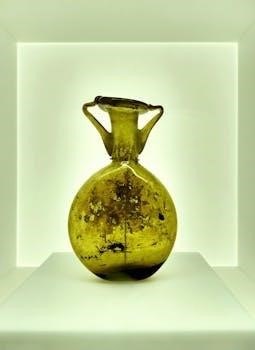the history of the world in 6 glasses pdf
Summary
Download ‘The World in 6 Glasses’ PDF and journey through history, one drink at a time! Explore civilizations through beer, wine, spirits, & more. Get your PDF now!

A History of the World in 6 Glasses⁚ An Article Plan
This article outlines a journey through time, exploring how six beverages—beer, wine, spirits, coffee, tea, and Coca-Cola—have significantly shaped human history from the Stone Age to the 21st century. Each drink mirrors distinct eras and their societal developments.
Throughout history, certain beverages have played a role far beyond simple refreshment. Tom Standage’s “A History of the World in 6 Glasses” explores this fascinating phenomenon, arguing that drinks like beer, wine, spirits, coffee, tea, and Coca-Cola have profoundly influenced the course of civilization. These beverages aren’t merely thirst-quenchers; they are intertwined with pivotal moments in human history, reflecting the social, economic, and political landscapes of their respective eras.
From ancient civilizations to the modern era, the consumption and trade of these drinks have shaped cultural practices, spurred exploration, and even fueled revolutions. Beer, for instance, played a crucial role in the agricultural revolution, while wine was integral to the development of ancient empires. Similarly, spirits facilitated exploration and colonialism, coffee sparked intellectual awakenings, tea fueled empire-building, and Coca-Cola symbolized Americanization in the 20th century. By examining these six drinks, Standage offers a unique and engaging perspective on the interconnectedness of human history, revealing how seemingly simple beverages have left an indelible mark on the world.
The Premise⁚ Six Drinks, a World History
Tom Standage’s “A History of the World in 6 Glasses” operates on the intriguing premise that the story of humanity can be told through the lens of six key beverages⁚ beer, wine, spirits, coffee, tea, and Coca-Cola. These drinks, according to Standage, are not merely refreshments but cultural artifacts that reflect and have actively shaped historical events, social structures, and economic systems.
The book posits that each beverage corresponds to a specific era in human history, acting as a marker of significant developments and transformations. Beer, for example, is linked to the rise of agriculture and settled societies, while wine is associated with the growth of ancient civilizations and empires. Spirits played a crucial role in the age of exploration and colonialism, and coffee spurred intellectual discourse during the Enlightenment. Tea, with its impact on empire building and global trade, and Coca-Cola, as a symbol of Americanization in the 20th century, complete the narrative. By tracing the history of these six drinks, Standage offers a unique and accessible perspective on the sweep of world history, demonstrating how beverages have been both products and agents of change.
Beer⁚ From Stone Age Brew to Agricultural Revolution
In “A History of the World in 6 Glasses,” Tom Standage illuminates the profound connection between beer and the agricultural revolution, asserting that the pursuit of beer may have been a catalyst for the shift from nomadic hunter-gatherer societies to settled agricultural communities.

The book details how the earliest evidence of beer production dates back to the Stone Age, suggesting that the desire for this fermented beverage played a significant role in the domestication of grains like barley and wheat. The cultivation of these crops, initially for brewing purposes, led to the development of agriculture and the establishment of permanent settlements. Beer became an integral part of early civilizations, serving not only as a source of sustenance but also as a social lubricant and a ritualistic offering.
Standage emphasizes that beer’s prevalence in ancient societies, such as Mesopotamia and Egypt, highlights its cultural and economic importance. It was used as a form of payment, a dietary staple, and a key component of religious ceremonies. The book effectively argues that beer was far more than just a drink; it was a cornerstone of civilization, driving agricultural innovation and shaping the social fabric of early human societies.
Wine⁚ Civilization and Ancient Empires
In “A History of the World in 6 Glasses,” Standage explores wine’s pivotal role in shaping civilization and the rise of ancient empires. Wine, unlike beer, ascended as the drink of choice for the elite, symbolizing status, sophistication, and cultural refinement in ancient Greece and Rome.
The cultivation of grapes and the production of wine fostered trade networks and economic growth across the Mediterranean. Wine became deeply intertwined with religious rituals, social gatherings, and political ceremonies, solidifying its place at the heart of ancient societies. Standage argues that wine’s association with the upper classes and its central role in symposia and banquets helped disseminate knowledge, philosophy, and artistic expression throughout the ancient world.
Moreover, the standardization of wine production and distribution facilitated the expansion and consolidation of empires. Wine served as a marker of Roman civilization, spreading alongside their legions and infrastructure, influencing the cultures and economies of conquered territories. Through wine, Standage illustrates how a simple beverage could embody and propel the development of civilization and the expansion of empires.
Spirits⁚ Exploration, Trade, and Colonialism
Standage’s “A History of the World in 6 Glasses” delves into the significant role spirits played in the age of exploration, trade, and colonialism. The advent of distillation led to the creation of potent beverages like rum, brandy, and whiskey, which became integral to global trade routes and colonial expansion.

Spirits, particularly rum, fueled the infamous triangular trade, connecting Europe, Africa, and the Americas. Rum was exchanged for slaves in Africa, who were then transported to the Americas to produce sugar, which was in turn used to make more rum in Europe. This cycle of exploitation and trade had a profound and devastating impact on societies across the globe.
Moreover, spirits served as a tool of colonization, with European powers using alcohol to control and manipulate indigenous populations. The availability and trade of spirits often led to social disruption and dependency, further entrenching colonial power. Standage argues that spirits, therefore, were not just beverages but potent agents in the complex and often brutal history of exploration and colonialism.
Coffee⁚ The Age of Reason and Intellectual Awakening
In “A History of the World in 6 Glasses,” Standage explores coffee’s pivotal role during the Age of Reason and the intellectual awakening that swept across Europe. The rise of coffee houses in the 17th and 18th centuries offered a new social space distinct from taverns, fostering intellectual discourse and scientific exchange.

Unlike alcohol, coffee promoted alertness and clarity, making it the ideal beverage for scholars, writers, and thinkers. Coffee houses became hubs for sharing ideas, debating philosophies, and conducting business. They were often referred to as “penny universities” because for the price of a cup of coffee, one could engage in stimulating conversations and learn about the latest news and scientific discoveries.
Standage argues that coffee houses played a crucial role in the Enlightenment, providing a platform for the spread of knowledge and the challenging of traditional authority. The stimulating effects of coffee fueled intellectual productivity and contributed to the era’s emphasis on reason, science, and individual liberty, marking a significant shift in European society and culture.
Tea⁚ Empire Building and Global Trade
Tea, as explored in “A History of the World in 6 Glasses,” played a significant role in empire building and the expansion of global trade, particularly for the British Empire. Originating in Asia, tea became a highly sought-after commodity in Europe, driving extensive trade networks and shaping international relations.
The demand for tea led to the establishment of the British East India Company, which wielded immense power and influence over trade routes and territories in Asia. The tea trade fueled the growth of the British Empire, as the company sought to control tea production and distribution, leading to conflicts and colonization.
The Boston Tea Party, a pivotal event in American history, highlighted the tensions arising from the tea trade and British taxation policies. Tea became a symbol of colonial resistance and contributed to the outbreak of the American Revolution. Standage illustrates how tea’s global reach and economic significance intertwined with political and social upheavals, shaping the course of history and international relations.
Coca-Cola⁚ Americanization and the 20th Century
Coca-Cola, as highlighted in “A History of the World in 6 Glasses,” symbolizes Americanization and the cultural landscape of the 20th century. Originating in the late 19th century, Coca-Cola quickly transcended its humble beginnings as a medicinal tonic to become a global phenomenon, synonymous with American culture and capitalism.
Standage explores how Coca-Cola’s marketing strategies and widespread distribution contributed to its global dominance, penetrating diverse markets and becoming a ubiquitous symbol of modernity. The beverage’s association with American values and lifestyles played a significant role in shaping consumer culture and influencing social trends worldwide.
Coca-Cola’s presence in various historical events, from World War II to the Cold War, further solidified its status as an emblem of American influence and cultural export. The book examines how Coca-Cola’s rise reflects broader trends of globalization and the dissemination of American culture, impacting societies and economies across the globe throughout the 20th century.
Drinking as a Social Behavior⁚ Uniting People
Tom Standage emphasizes in “A History of the World in 6 Glasses” that drinking is fundamentally a social behavior, acting as a potent force in uniting people across diverse backgrounds. The book illustrates how the ritual of sharing beverages has fostered connections, facilitated communication, and strengthened communities throughout history.
From ancient symposiums fueled by wine to coffee houses that sparked intellectual revolutions, Standage demonstrates how specific drinks have historically created spaces for social interaction and exchange. These communal settings allowed individuals to converge, debate ideas, and forge bonds that transcended social barriers.

The act of sharing a drink often signifies hospitality, friendship, and trust, reinforcing social cohesion and promoting a sense of belonging. Standage examines how the cultural significance attributed to various beverages has shaped social norms, influenced diplomatic relations, and even played a role in resolving conflicts, highlighting the enduring power of drinking as a social catalyst.
The Interconnectedness of Cultures Through Libations
“A History of the World in 6 Glasses” vividly portrays how beverages have served as conduits for cultural exchange and interconnectedness throughout history. Tom Standage masterfully illustrates how the movement of drinks like beer, wine, spirits, coffee, tea, and Coca-Cola across geographical boundaries has fostered interactions between disparate cultures.
The book reveals how the trade and consumption of these beverages have facilitated the transmission of ideas, technologies, and customs, blurring cultural lines and shaping global dynamics. Standage explores how the introduction of new drinks often led to the adoption of new agricultural practices, culinary traditions, and social rituals, creating a complex web of cultural interdependence.
Moreover, the adaptation and modification of these beverages in different regions have resulted in unique local variations, reflecting the diverse cultural influences at play. By tracing the global journey of these six drinks, Standage uncovers the intricate ways in which cultures have influenced and enriched one another through the shared experience of libations.
Standage’s Narrative Lens⁚ A Unique Approach to History
Tom Standage’s “A History of the World in 6 Glasses” distinguishes itself through its innovative narrative lens, offering a refreshing perspective on historical events. Instead of focusing solely on traditional political, military, or economic narratives, Standage cleverly utilizes beverages as a unique entry point to explore broader historical trends.
By examining the production, distribution, and consumption of beer, wine, spirits, coffee, tea, and Coca-Cola, Standage unveils the social, cultural, and technological forces that have shaped human civilization. This approach allows him to weave together seemingly disparate threads of history, revealing unexpected connections and patterns.
Standage’s narrative is engaging and accessible, making complex historical concepts relatable to a wide audience. He masterfully blends historical analysis with captivating anecdotes, bringing the past to life through the lens of everyday drinks. This unique approach not only offers a fresh perspective on history but also underscores the importance of seemingly mundane aspects of life in understanding broader historical developments. Standage’s work demonstrates the power of innovative storytelling in illuminating the past.
Criticism and Reception of the Book
Tom Standage’s “A History of the World in 6 Glasses” has garnered widespread acclaim and attention, but like any popular work, it has also faced its share of criticism. While many reviewers have praised Standage’s innovative approach and engaging writing style, some critics have raised concerns about the book’s scope and depth.
Some argue that focusing solely on beverages as a lens through which to view history may oversimplify complex historical processes. They contend that other factors, such as technological advancements, political ideologies, and social movements, play a more significant role in shaping historical events. Additionally, some critics have questioned Standage’s selection of beverages, suggesting that other drinks may have had an equal or greater impact on certain historical periods.
Despite these criticisms, “A History of the World in 6 Glasses” has been largely well-received by both general readers and academic audiences. Its accessible style and unique perspective have made it a popular choice for book clubs and history enthusiasts. The book’s success lies in its ability to spark curiosity about the past and encourage readers to think about history in new and unconventional ways.
Beverages as a Reflection of Human History
The book effectively argues that these drinks are not merely refreshments but also cultural artifacts that reflect the values, beliefs, and social structures of different societies. From the communal beer-drinking rituals of ancient civilizations to the coffeehouse culture of the Enlightenment, beverages have consistently played a central role in shaping human interactions and shaping historical narratives;
While some critics may argue that Standage’s focus is overly narrow, the book’s strength lies in its ability to illuminate the interconnectedness of cultures and the surprising ways in which everyday objects can offer valuable insights into the past. “A History of the World in 6 Glasses” ultimately invites readers to reconsider their understanding of history and appreciate the profound impact that even the simplest of pleasures can have on the world around us.